tow PONTIAC PONTIAC 1996 Owner's Guide
[x] Cancel search | Manufacturer: PONTIAC, Model Year: 1996, Model line: PONTIAC, Model: PONTIAC PONTIAC 1996Pages: 370, PDF Size: 17.69 MB
Page 216 of 370

If a Tire Goes Flat
It’s unusual for a tire to “blow out” while you’re driving,
especially if you maintain your tires properly. If air goes
out of a tire, it’s much more likely to leak out slowly.
But
if you should ever have a “blowout,” here are a few
tips about what to expect and what to do:
If a front tire fails, the flat tire will create
a drag that
pulls the vehicle toward that side. Take your foot
off the
accelerator pedal and grip the steering wheel firmly.
I
Steer to maintain lane position, and then gently brake to
a stop well out
of the traffic lane.
A rear blowout, particularly on a curve, acts much like a
skid and may require the same correction you’d; use in a
skid. In any rear blowout, remove your foot from the
accelerator pedal. Get
the vehicle under control by
steering the way you want the vehicle to
go. It may be
very bumpy and noisy, but you can still steer. Gently
brake
to a stop -- well off the road if possible.
If a tire goes flat, the next part shows how to use your
jacking equipment to change a flat tire safely.
Changing a Flat Tire
If a tire goes flat, avoid further tire and wheel damage
by driving slowly to a level place. Turn
on your hazard
warning flashers.
Changing a tire can cause an injury. The vehicle
can slip off the jack and roll over you or other
people. You and they could be badly injured.
Find a level place to change your tire.
To help
prevent the vehicle from moving:
1. Set the parking brake firmly.
2. Put the shift lever in PARK (P).
3. nrn off the engine.
To be even more certain the vehicle won’t move,
you can put blocks at the front and rear of the
tire farthest away from the one being changed.
That would be the tire
on the other side of the
vehicle, at the opposite end.
ProCarManuals.com
Page 221 of 370
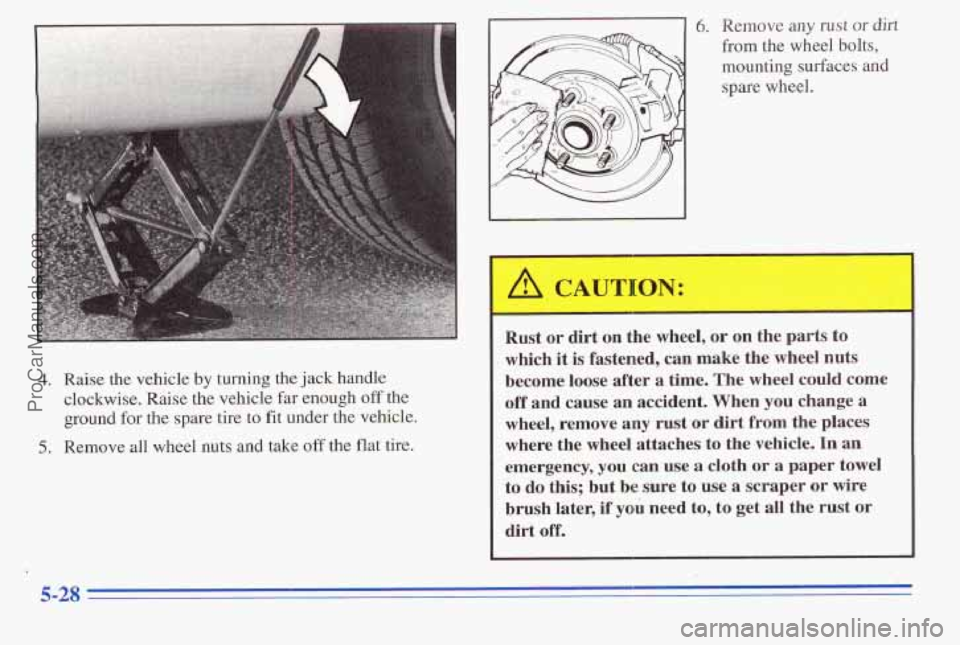
4. Raise the vehicle by turning the jack handle
clockwise. Raise the vehicle far enough
off the
ground
for the spare tire to fit under the vehicle.
5. Remove all wheel nuts and take off the flat tire.
6. Remove any rust or dirt
from the wheel bolts,
mounting surfaces and
spare wheel.
A CAUTION:
3'LO -
Rust or dirt on the wheel, or on the parts to
which it is fastened, can make the wheel nuts
become loose
after a time. The wheel could come
off and cause
an accident. When you change a
wheel, remove any rnst
or dirt from the places
where the wheel attaches to
the vehicle. In an
emergency, you can use a cloth or a paper towel
to do this; but be sure to use a scraper or wire
brush later, if
you need to, to get all the rust or
dirt off.
ProCarManuals.com
Page 222 of 370

Never use oil or grease on studs or nuts. If you
do, the nuts might come loose. Your wheel could
fall off, causing a serious accident.
7. Replace the wheel nuts with the rounded end
of the nuts toward the
wheel. Tighten each nut
8. Lower the vehicle by turning the jack handle
counterclockwise. Lower the jack completely.
5-29
ProCarManuals.com
Page 227 of 370
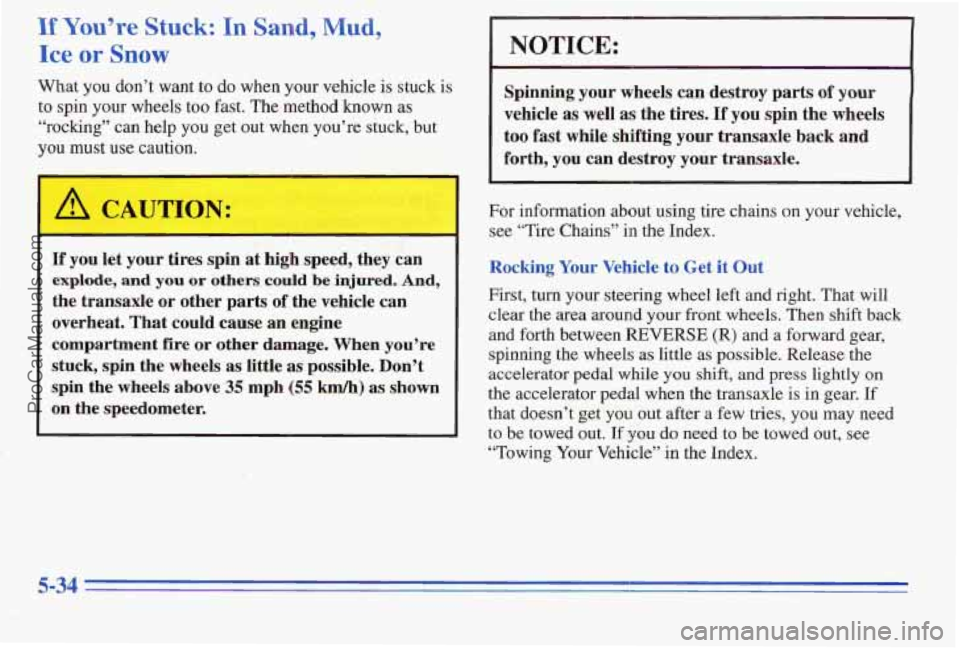
If You’re Stuck: In Sand, Mud,
Ice or Snow
What you don’t want to do when your vehicle is stuck is
to spin your wheels too fast. The method known as
“rocking” can help you get out when you’re stuck, but
you must use caution.
If you let your tires spin at high speed, they can
explode, and you or others could be injured. .And,
the transaxle or other parts of the vehicle can
overheat. That could cause an engine
compartment
fire or other damage. When you’re
stuck, spin the wheels as little as possible. Don’t
spin the wheels above
35 mph (55 M) as shown
on the speedometer.
NOTICE:
Spinning your wheels can destroy parts of your
vehicle
as well as the tires. If you spin the wheels
too
fast while shifting your transaxle back and
forth, you can destroy your transaxle.
For information about using tire chains on your vehicle,
see “Tire Chains” in the Index.
Rocking Your Vehicle to Get it Out
First, turn your steering wheel left and right. That will
clear the area around your front wheels. Then shift back
and forth between REVERSE (R) and a forward gear,
spinning the wheels as little as possible. Release
the
accelerator pedal while you shift, and press lightly on
the ‘accelerator pedal when the transaxle is in gear. If
that doesn’t get you out after a few tries, you may need
to be towed out.
If you do need to be towed out, see
“Towing Your Vehicle” in
the Index.
ProCarManuals.com
Page 238 of 370
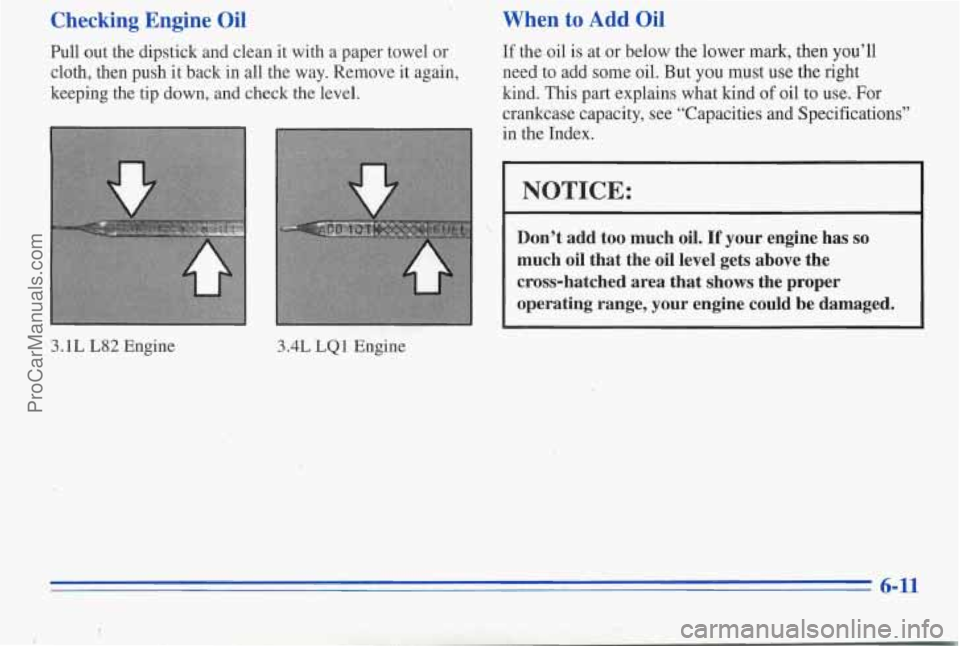
Checking Engine Oil When to Add Oil
Pull out the dipstick and clean it with a paper towel or If the oil is at or below the lower mark, then you’ll
cloth, then push it back in all the way. Remove it again, need to add some oil. But you must use the right
keeping the tip down, and check the level. kind. This part explains what kind
of oil to use.-For
crankcase capacity, see “Capacities and Specifications”
in the Index.
NOTICE:
Don’t, add too much oil. If your engine has so
much oil that the oil level gets above the
cross-hatched area that shows the proper
operating range,
your engine could be damaged.
3.1 L L82 Engine 3.4L LQ1 Engine
6-11
ProCarManuals.com
Page 242 of 370

When to Change Engine Oil
See if any one of these is true for you:
0
a
a
a
a
Most trips are less than 5 to 10 miles (8 to 16 km).
This is particularly important when outside
temperatures are below freezing.
Most trips include extensive idling (such as frequent
driving
in stop-and-go traffic).
Most trips are through dusty areas.
You frequently tow a trailer or use a carrler on top of
your vehicle.
The vehicle is used for delivery service, police, taxi
or other commercial application.
5
i
Driving under these conditions causes engine oil to
break down sooner. If any one of these is true for your
vehicle, then you need to change your oil and filter
every
3,000 miles (5 000 km) or 3 months -- whichever
occurs first.
If none of them
is true, change the oil and filter every
7,5080 miles (12 500 km) or 12 months -- whichever
occurs first. Driving a vehicle with a fully warmed
engige mder highway conditions causes engine oil to
break down slower.
What to Do with Used Oil
Did you know that used engine oil contains certain
elements that may
be unhealthy for your skin and could
even cause cancer? Don't let used oil stay on .your skin
for very long. Clean your skin and nails with soap and
water, or'a good hand cleaner. Wash or properly throw
away clothing or rags containing used engine oil. (See
the manufacturer's warnings about the use and disposal
of oil products.)
.;4;-". ; ' '*?-
Used oil can be a real threat to the environment. If you
change your own oil, be sure to drain all free-flowing oil.
from the filter before disposal. Don't ever dispose of oil
by putting it in the trash, pouring it on the ground, into
sewers, or into streams or bodies of water. Instead,
recycle
it by taking it to a place that collects used oil. Lf
you have a problem properly disposing of your used oil,
ask your dealer, a service station or
a local recycling
center for help.
?&-.;.';z ;a
ProCarManuals.com
Page 244 of 370
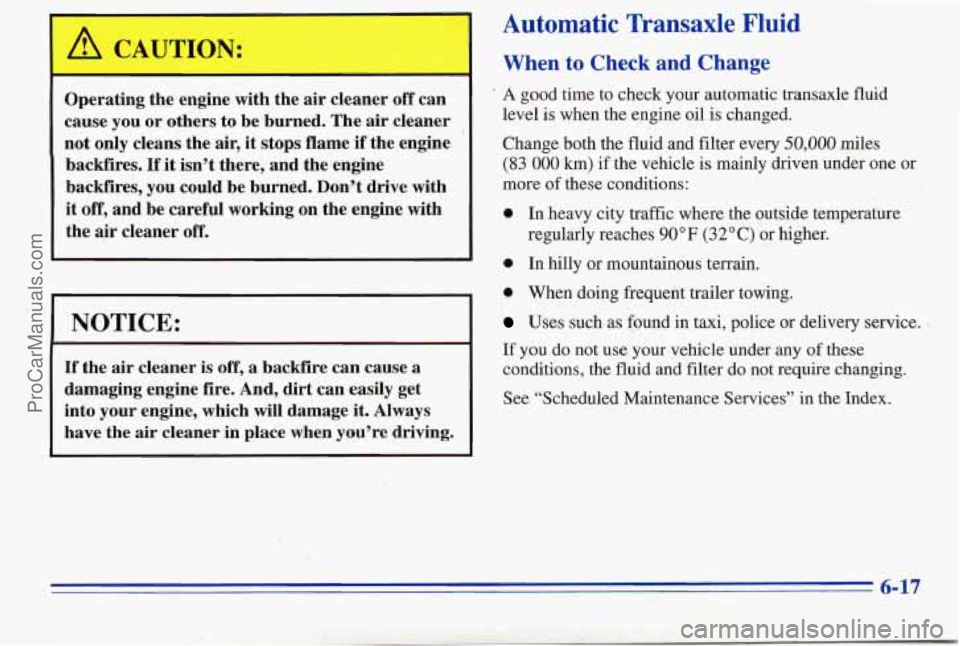
Operating the engine with the air cleaner off can
cause you or others to
be burned. The air cleaner
not only cleans the air, it stops flame if the,engine
backfires.
If it isn’t there, and the engine
backfires, you could be burned. Don’t drive with
it
off, and be careful working on the engine with
the air cleaner off.
I NOTICE:
If the air cleaner is off, a backfire can cause a
damaging engine fire. And, dirt can easily get
into your engine, which will damage it. Always
have the air cleaner in place when you’re driving.
Automatic Transaxle Fluid
When to Check and Change
A good time to check your automatic transaxle fluid
level is when the engine oil is changed.
Change both the fluid and filter every
50,000 miles
(83 000 km) if the vehicle is mainly driven under one or
more of these conditions:
0 In heavy city traffic where the outside temperature
0 In hilly or mountainous terrain.
regularly reaches
90°F (32” C) or higher.
0 When doing
frequent trailer towing.
Uses such as found in taxi, police or delivery service.
If
YOU do not use your vehicle under any of these
conditions, the fluid
and filter do not require changing.
See “Scheduled Maintenance Services” in the Index.
ProCarManuals.com
Page 246 of 370

Checking the Fluid Level
Park your vehcle on a level place. Keep the
0 With the parlung brake applied, place the shift lever
engine
running.
in
PARK (P).
lever through each gear range, pausing for about
three seconds in each range. Then, position the shift
lever in
PARK (P).
With your foot on the brake pedal, move the shift
0 Let the engine run at idle for three to five minutes.
Then, without shutting off the engine, follow these steps:
3.1L L82 Engine
3.4L LQ 1 Engine 1.
The transaxle fluid dipstick handle is the red loop
near the back of the engine. Pull out the dipstick and
wipe it with a clean rag or paper towel.
then pull it back out again.
2. Push it back in all the way, wait three seconds and
3.1L
L82 Engine 3.4L LQ 1 Engine
3. Check both sides of the dipstick, and read the
lower level. The fluid level must be in the
cross-hatched area.
4.
If the fluid level is in the acceptable range, push the
dipstick back in all the way.
ProCarManuals.com
Page 278 of 370
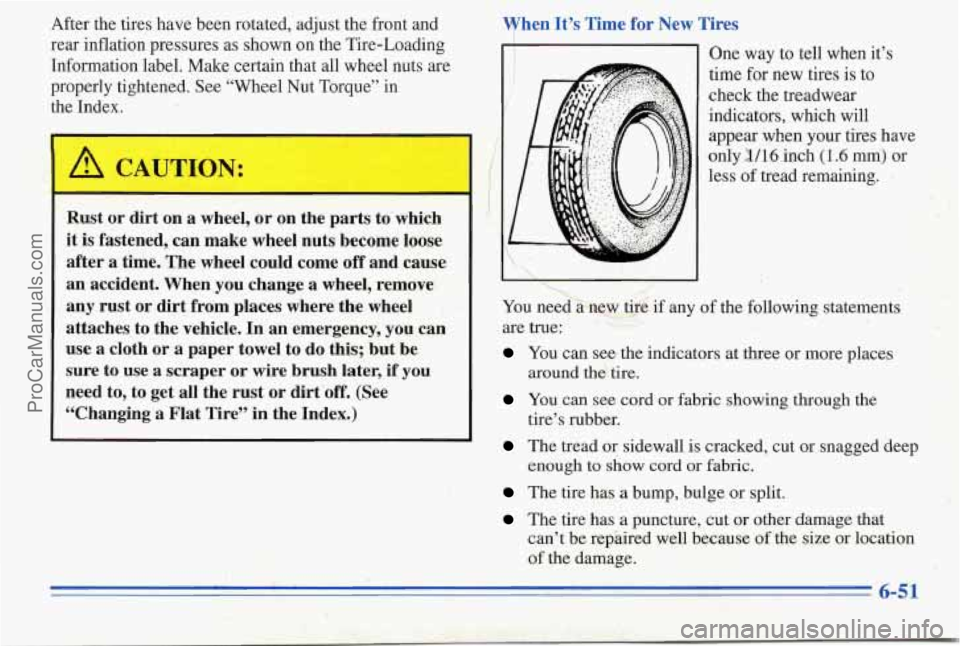
After the tires have been rotated, adjust the front and
rear inflation pressures as shown on the Tire-Loading
Information label. Make certain that all wheel nuts are
properly tightened. See “Wheel Nut Torque” in
the Index.
Rust or dirt on a wheel, or on the parts to-which
it is fastened, can make wheel nuts become loose
after a time. The wheel could come
off and cause
an accident. When you change a wheel, remove
any rust or dirt from places where the wheel
attaches to the vehicle. In an emergency, you can
use a cloth or
a paper towel to do this; but be
sure to use a scraper or wire brush later,
if you
need to, to get all the rust or dirt ‘off. (See
“Changing a Flat Tire” in the Index.)
/ I
I 1 I
Then It’s Time for New Tires
One way to tell when it’s
time for new tires is to
check the treadwear
indicators, which will
appear when your tires have
only
11/16 inch (I .6 mm) or
less of tread remaining.
ll.
You needknwt.re if any of the following statements
are true:
You can see. the indicators at three or more places
You can see cord or fabric showing through the
The tread or sidewall is cracked, cut or snagged deep
~~
around the tire.
tire’s rubber.
6,’ . 1. ‘ 1 enough to show cord or fabric. -. . . ..
;C I ., The tire has a bump, bulge or split.
-1 P. The tire has a puncture, cut or other damage that
can’t be repaired well because
of the size or location
of the damage.
6-51
ProCarManuals.com
Page 284 of 370

Don't use any of these unless this manual says you can.
In many uses, these will damage your vehicle:
Alcohol
Laundry Soap
Bleach
If a ring forms after spot cleaning, clean the entire
area immediately or it will set.
Using Foam-Type Cleaner on Fabric
..
1. Vacuum and brush the area to remove any
loose dirt.
Reducing Agents 2. Always clean a whole trim panel or section. Mask
Cleaning the Inside of Your Pontiac
surrounding trim along stitch or welt lines.
3. Mix Multi-Purpose Powdered Cleaner following
4. Use suds only and apply with a clean sponge.
5. Don't saturate the material.
Use a vacuum cleaner often
to get
.rid of dust and loose the directions on the container label.
dirt. Wipe vinyl or leather with a clean, damp cloth.
Your Pontiac dealer has
two GM cleaners, a
solvent-type spot lifter and
a foam-type powdered
cleaner. They will clean normal spots and stains very
6. Don't rub it roughly. I , ,, ' . - ,;,: ~ .-.,<~, . ., ', 1 . ',-'.: ;,I>< ' y. +?;= :=
well. Do not use them on vinyl or leather.
Here are some cleaning tips:
to remove the suds.
Always read the'instructions on the cleaner label.' 8. Rinse the section with a clean, wet sponge.
~ - ; :i e,, '9 I ;i' I . -~ - . . -7 ..
7. As soon as you've cleaned the section, use a sponge ,< . .. .h
Clean up stains as soon as you can -- before they set. 9. Wipe off what's left with a slightly damp paper
Use a clean cloth or sponge, and change to a
clean area often.
A soft brush may be used if stains 10. Then dry it immediately with a blow dryer.
are stubborn. towel
or cloth.
11. Wipe with
a clean cloth.
Use solvent-type cleaners in a well-ventilated area
only. If you use them, don't saturate the stained area. ." , 7 I. ... : * -4..y> .
, ,.it. i , ' I: :.I ..' k.,
c57
ProCarManuals.com